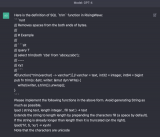本文是通過(guò) SQL 計(jì)算同時(shí)在線問(wèn)題,即求最高在線人數(shù)以及最高峰時(shí)間段。
0 需求分析
數(shù)據(jù)為主播ID,stt表示開(kāi)播時(shí)間,edt表示下播時(shí)間。
idsttedt
10012021-06-14 12122021-06-14 1812
10032021-06-14 13122021-06-14 1612
10042021-06-14 13122021-06-14 2012
10022021-06-14 15122021-06-14 1612
10052021-06-14 15122021-06-14 2012
10012021-06-14 20122021-06-14 2312
10062021-06-14 21122021-06-14 2312
10072021-06-14 22122021-06-14 2312
求:
(1)該平臺(tái)某一天主播同時(shí)在線人數(shù)最高為多少?
(2)出現(xiàn)最高峰的時(shí)間段是哪個(gè)時(shí)間?
1 數(shù)據(jù)準(zhǔn)備
(1)數(shù)據(jù)
vim play.txt
idstt edt
10012021-06-14 1212 2021-06-14 1812
10032021-06-14 13122021-06-14 1612
10042021-06-14 13122021-06-14 2012
10022021-06-14 15122021-06-14 1612
10052021-06-14 15122021-06-14 2012
10012021-06-14 20122021-06-14 2312
10062021-06-14 21122021-06-14 2312
10072021-06-14 22122021-06-14 2312
(2) 建表
create table if not exists play(
id string,
stt string,
edt string
)
row format delimitedfields terminated by ‘ ’
;
(3 )加載數(shù)據(jù)
load data local inpath “/home/centos/dan_test/play.txt” into table play;
(4) 查詢(xún)數(shù)據(jù)
hive》 select * from play;
OK
1001 2021-06-14 12:12:12 2021-06-14 18:12:121003 2021-06-14 13:12:12 2021-06-14 16:12:121004 2021-06-14 13:15:12 2021-06-14 20:12:121002 2021-06-14 15:12:12 2021-06-14 16:12:121005 2021-06-14 15:18:12 2021-06-14 20:12:121001 2021-06-14 20:12:12 2021-06-14 23:12:121006 2021-06-14 21:12:12 2021-06-14 23:15:121007 2021-06-14 22:12:12 2021-06-14 23:10:12
Time taken: 0.087 seconds, Fetched: 8 row(s)
2 數(shù)據(jù)分析
問(wèn)題1分析:
本題如果直接從SQL本身很難下手,無(wú)從做起,不妨我們換個(gè)思路,假定我們拿到的是一條數(shù)據(jù),現(xiàn)在用java程序怎么做?其實(shí)就是一個(gè)累加器的思想(如SPARK的累加器)。首先我們需要將這樣一條記錄進(jìn)行拆分,分成不同的記錄或數(shù)據(jù)流進(jìn)入累加器,然后給每條記錄進(jìn)行標(biāo)記,如果開(kāi)播的話該條記錄記為1,下播的話記為-1,此時(shí)的數(shù)據(jù)流按照時(shí)間順序依次進(jìn)入累加器,然后在累加器中進(jìn)行疊加,其中累計(jì)的結(jié)果最大時(shí)候就是所求的結(jié)果。其實(shí)本質(zhì)是利用累加器思想,但進(jìn)入累加器的數(shù)據(jù)是按時(shí)間排好序的時(shí)序流數(shù)據(jù)(數(shù)據(jù)進(jìn)入按時(shí)間先后順序進(jìn)入)。
上述思路總結(jié)如下:
(1)將數(shù)據(jù)切分(按起始時(shí)間和結(jié)束時(shí)間)
(2)數(shù)據(jù)進(jìn)行標(biāo)簽,開(kāi)播的記錄為記為1,下播的記錄記為-1用于累加
(2)將數(shù)據(jù)按時(shí)間進(jìn)行排序
(3)數(shù)據(jù)進(jìn)入累加器進(jìn)行累加
(4)獲取累加器中當(dāng)前累加值最大的數(shù)值
有了以上思路后,我們將其轉(zhuǎn)換為SQL求解思路。
(1)將數(shù)據(jù)切分:實(shí)際上就是將開(kāi)播時(shí)間和下播時(shí)間轉(zhuǎn)換成一條條記錄。也就是列轉(zhuǎn)行,我們用熟悉的UNION操作,進(jìn)行轉(zhuǎn)換。
select id,stt dt from play
unionselect id,edt dt from play
--------------------------------------------------------------------------------
OK
1001 2021-06-14 12:12:121001 2021-06-14 18:12:121001 2021-06-14 20:12:121001 2021-06-14 23:12:121002 2021-06-14 15:12:121002 2021-06-14 16:12:121003 2021-06-14 13:12:121003 2021-06-14 16:12:121004 2021-06-14 13:15:121004 2021-06-14 20:12:121005 2021-06-14 15:18:121005 2021-06-14 20:12:121006 2021-06-14 21:12:121006 2021-06-14 23:15:121007 2021-06-14 22:12:121007 2021-06-14 23:10:12
Time taken: 20.502 seconds, Fetched: 16 row(s)
(2) 數(shù)據(jù)標(biāo)記。在上述SQL基礎(chǔ)上直接進(jìn)行標(biāo)記即可。如果數(shù)據(jù)本來(lái)就是分開(kāi)的則用case when進(jìn)行標(biāo)記。
select id,stt dt , 1 flag from play
unionselect id,edt dt ,-1 flag from play
--------------------------------------------------------------------------------
OK
1001 2021-06-14 12:12:12 11001 2021-06-14 18:12:12 -11001 2021-06-14 20:12:12 11001 2021-06-14 23:12:12 -11002 2021-06-14 15:12:12 11002 2021-06-14 16:12:12 -11003 2021-06-14 13:12:12 11003 2021-06-14 16:12:12 -11004 2021-06-14 13:15:12 11004 2021-06-14 20:12:12 -11005 2021-06-14 15:18:12 11005 2021-06-14 20:12:12 -11006 2021-06-14 21:12:12 11006 2021-06-14 23:15:12 -11007 2021-06-14 22:12:12 11007 2021-06-14 23:10:12 -1
Time taken: 7.408 seconds, Fetched: 16 row(s)
(3)數(shù)據(jù)按照時(shí)間排序,進(jìn)入累加器進(jìn)行累加(按時(shí)間排序是累加的關(guān)鍵)
select id
,dt
,sum(flag) over(order by dt) as cur_cnt
from(
select id,stt dt , 1 flag from play
union
select id,edt dt ,-1 flag from play
) t
--------------------------------------------------------------------------------
OK
1001 2021-06-14 12:12:12 11003 2021-06-14 13:12:12 21004 2021-06-14 13:15:12 31002 2021-06-14 15:12:12 41005 2021-06-14 15:18:12 51002 2021-06-14 16:12:12 31003 2021-06-14 16:12:12 31001 2021-06-14 18:12:12 21001 2021-06-14 20:12:12 11004 2021-06-14 20:12:12 11005 2021-06-14 20:12:12 11006 2021-06-14 21:12:12 21007 2021-06-14 22:12:12 31007 2021-06-14 23:10:12 21001 2021-06-14 23:12:12 11006 2021-06-14 23:15:12 0
Time taken: 8.133 seconds, Fetched: 16 row(s)
(4) 獲取累加器中當(dāng)前時(shí)刻累加的最大值,即為同時(shí)開(kāi)播最多的人數(shù)
select max(cur_cnt)
from(
select id
,dt
,sum(flag) over(order by dt) as cur_cnt
from(
select id,stt dt , 1 flag from play
union
select id,edt dt ,-1 flag from play
) t
) m
--------------------------------------------------------------------------------
OK
5
Time taken: 13.087 seconds, Fetched: 1 row(s)
問(wèn)題2分析:
第二問(wèn)求的是出現(xiàn)高峰時(shí)的時(shí)間段,也就是高峰時(shí)間的起始時(shí)間及結(jié)束時(shí)間,或持續(xù)時(shí)長(zhǎng)。
借鑒第一問(wèn)的結(jié)果進(jìn)行分析:
select *,max(cur_cnt) over()
from(
select id
,dt
,sum(flag) over(order by dt) as cur_cnt
from(
select id,stt dt , 1 flag from play
union
select id,edt dt ,-1 flag from play
) t
) m
通過(guò)上圖我們可以看出當(dāng)由峰值出的記錄時(shí)間到下一條記錄人數(shù)減少的時(shí)候這一段時(shí)間即為峰值持續(xù)的時(shí)間,或高峰的時(shí)間段,也就是求出峰值的下一條記錄的時(shí)間與峰值對(duì)應(yīng)記錄的時(shí)間即為高峰時(shí)間段,因此利用lead()函數(shù)很容易求出問(wèn)題的答案。SQL如下:
select max_cur_cnt
,dt as start_time
,lead_dt as end_time
from(
select *
,lead(dt,1,dt) over(order by dt) lead_dt
from(
select *,max(cur_cnt) over() as max_cur_cnt
from(
select id
,dt
,flag
,sum(flag) over(order by dt) as cur_cnt
from(
select id,stt dt , 1 flag from play
union
select id,edt dt ,-1 flag from play
) t
) m
) n
) p
where cur_cnt=max_cur_cnt
計(jì)算結(jié)果如下:
--------------------------------------------------------------------------------
OK
5 2021-06-14 15:18:12 2021-06-14 16:12:12
Time taken: 17.513 seconds, Fetched: 1 row(s)
3 小結(jié)
本文針對(duì)SQL統(tǒng)計(jì)同時(shí)在線人數(shù)問(wèn)題進(jìn)行了分析,利用累加器思想對(duì)該問(wèn)題進(jìn)行求解,最終劃歸為時(shí)序數(shù)據(jù),進(jìn)行時(shí)序數(shù)據(jù)分析(常用技巧:打標(biāo)簽,形成序列,多序列進(jìn)行分析),最后利用sum() over()對(duì)標(biāo)簽進(jìn)行累加求出當(dāng)前在線人數(shù)本題最關(guān)鍵的點(diǎn)在于轉(zhuǎn)換為時(shí)序數(shù)據(jù)及累加器的思想,望讀者能夠掌握。
事實(shí)上該問(wèn)題的分析在業(yè)務(wù)上具有重要的意義,我們能夠?qū)崟r(shí)跟蹤隨著時(shí)間變化的在線人數(shù),了解服務(wù)器的負(fù)載變化情況,服務(wù)器的實(shí)時(shí)并發(fā)數(shù)等。該問(wèn)題在不同業(yè)務(wù)場(chǎng)景下,有不同意義,比如某個(gè)游戲的同時(shí)在線人數(shù),比如某個(gè)服務(wù)器的實(shí)時(shí)并發(fā)數(shù),比如某個(gè)倉(cāng)庫(kù)的貨物積壓數(shù)量,某一段時(shí)間內(nèi)的同時(shí)處于服務(wù)過(guò)程中的最大訂單量等。實(shí)際上求最大在線人數(shù)和求實(shí)時(shí)在線人數(shù)是一回事,最大人數(shù)依賴(lài)于當(dāng)前在線人數(shù)表,只有先求出當(dāng)前在線人數(shù)表,才能求出最大同時(shí)在線人數(shù)。
不謀全局者,不足以謀一域。
不謀萬(wàn)世者,不足以謀一時(shí)。
作者: 石榴公子YYDS
https://blog.csdn.net/godlovedaniel/article/details/118651811
責(zé)任編輯:haq
-
數(shù)據(jù)
+關(guān)注
關(guān)注
8文章
6899瀏覽量
88842 -
SQL
+關(guān)注
關(guān)注
1文章
760瀏覽量
44080
原文標(biāo)題:3 小結(jié)
文章出處:【微信號(hào):DBDevs,微信公眾號(hào):數(shù)據(jù)分析與開(kāi)發(fā)】歡迎添加關(guān)注!文章轉(zhuǎn)載請(qǐng)注明出處。
發(fā)布評(píng)論請(qǐng)先 登錄
相關(guān)推薦
常用SQL函數(shù)及其用法
SQL與NoSQL的區(qū)別
大數(shù)據(jù)從業(yè)者必知必會(huì)的Hive SQL調(diào)優(yōu)技巧
IP 地址在 SQL 注入攻擊中的作用及防范策略
什么是 Flink SQL 解決不了的問(wèn)題?
SQL全外連接剖析

為什么需要監(jiān)控SQL服務(wù)器?
如何用Rust過(guò)程宏魔法簡(jiǎn)化SQL函數(shù)呢?

分布式無(wú)紙化交互系統(tǒng)如何支持多用戶(hù)同時(shí)在線編輯和協(xié)作?
數(shù)據(jù)庫(kù)編程大賽:一條SQL計(jì)算撲克牌24點(diǎn)

SQL核心知識(shí)點(diǎn)總結(jié)





 通過(guò)SQL計(jì)算同時(shí)在線問(wèn)題
通過(guò)SQL計(jì)算同時(shí)在線問(wèn)題










評(píng)論